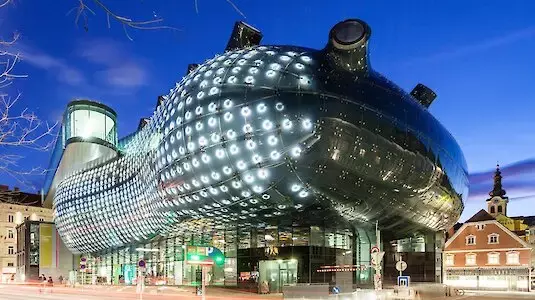Kunsthaus Graz

- Kunsthaus Graz, often referred to as the "Friendly Alien," is one of the most distinctive architectural landmarks in Graz. Designed by renowned architects Peter Cook and Colin Fournier, this futuristic structure was built in 2003 as part of the European Capital of Culture celebrations. Its biomorphic, bubble-like façade, made of blue acrylic panels, stands in stark contrast to the surrounding historic buildings, making it an eye-catching symbol of contemporary art and innovation. At night, the building transforms into a glowing installation thanks to its integrated lighting system, adding to its dynamic presence in the cityscape.
- Inside, Kunsthaus Graz serves as a hub for modern and contemporary art exhibitions. Unlike traditional museums, it does not house a permanent collection but instead focuses on temporary exhibitions featuring cutting-edge works by international and Austrian artists. The exhibitions cover a broad spectrum of artistic disciplines, including painting, sculpture, photography, digital media, and interactive installations. The curators emphasize experimentation and new media, making the museum a vital space for artistic exploration and cultural discourse.
- The interior layout of Kunsthaus Graz is as unconventional as its exterior. The main exhibition space, known as the "BIX Façade," is an open, fluid environment designed to accommodate a variety of artistic expressions. The building also includes a media lounge, a café with panoramic city views, and a well-curated museum shop. The unique architectural design eliminates sharp corners and traditional gallery formats, encouraging visitors to engage with the exhibits in a more immersive way.
- Beyond its exhibitions, Kunsthaus Graz plays an important role in the city’s cultural life. It hosts workshops, lectures, film screenings, and community events that bring together artists, scholars, and the public. As a beacon of contemporary creativity in a city known for its historical charm, Kunsthaus Graz offers a fascinating contrast to the past while pushing the boundaries of artistic innovation.
